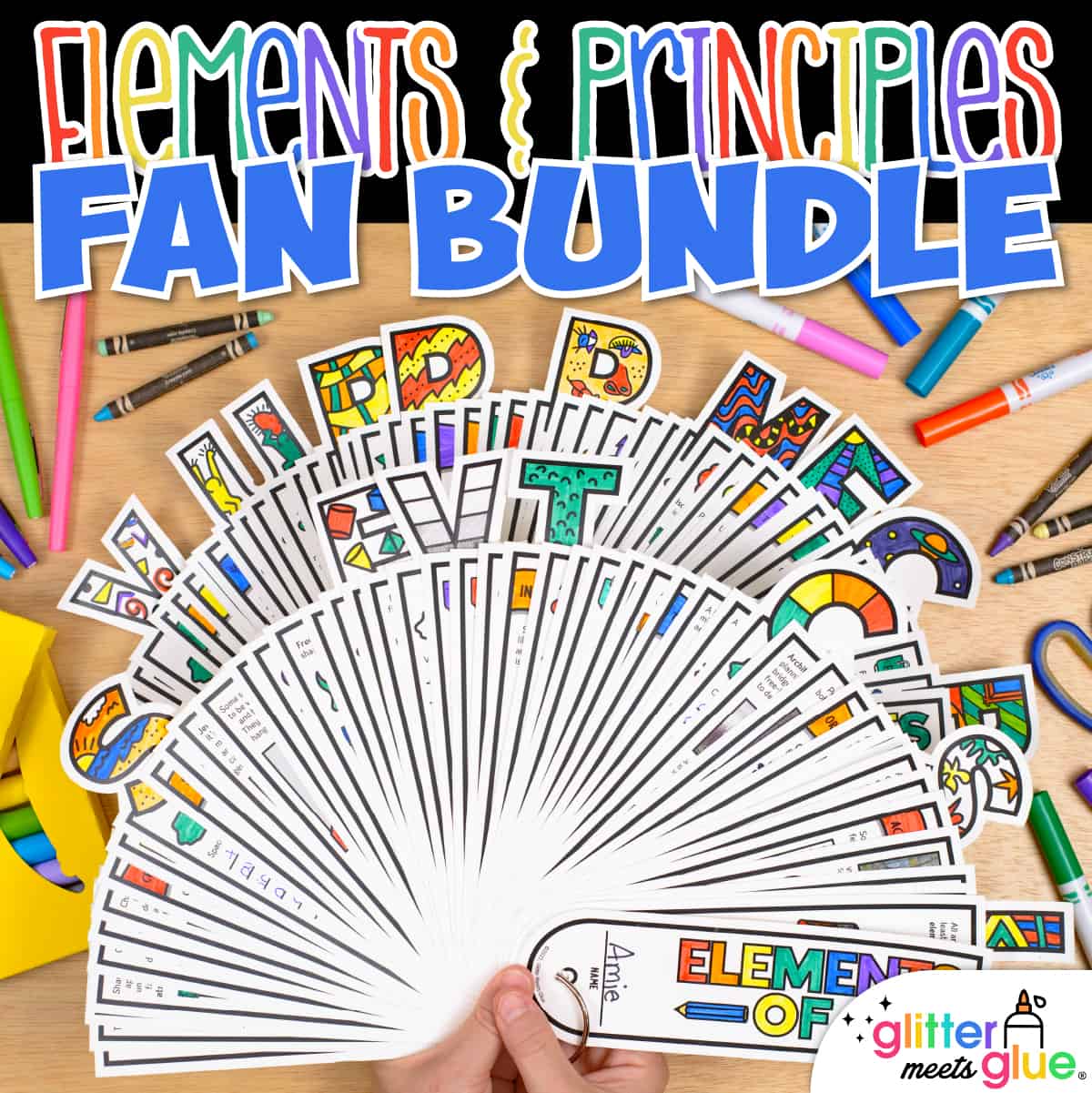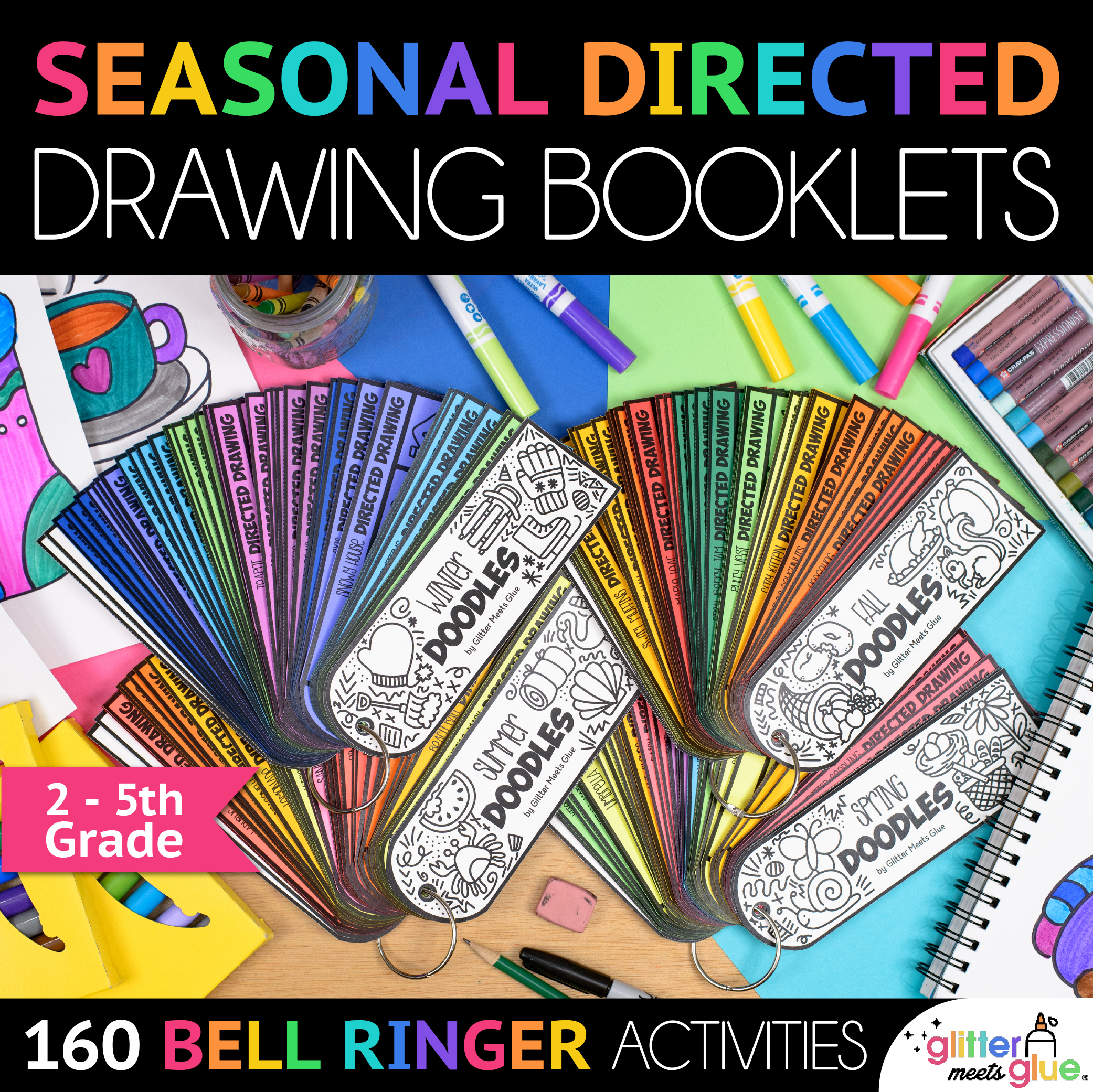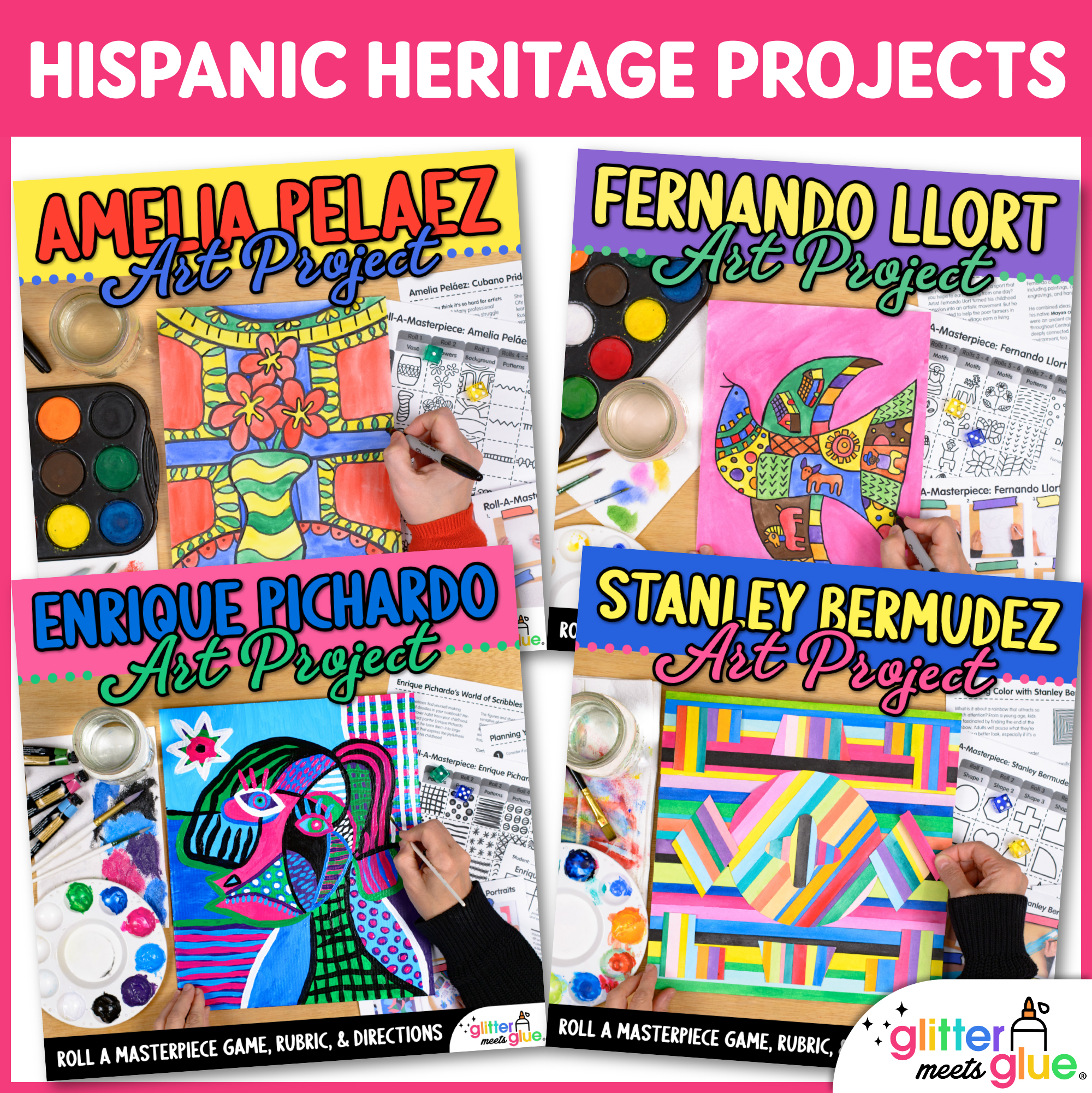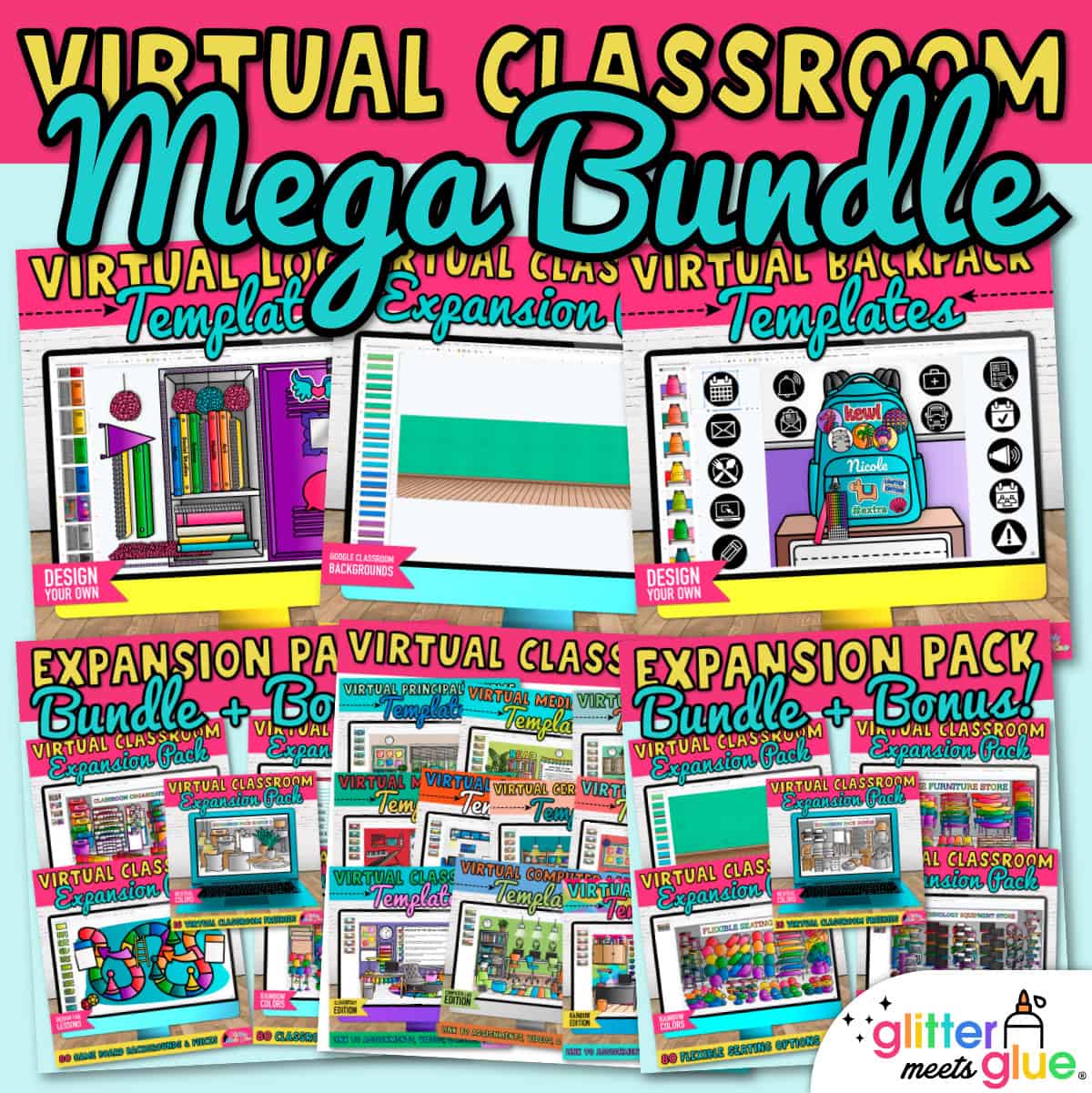Elements of Art and Principles of Design Interactive Fan Bundle
Let’s be real. Teaching the elements of art and principles of design to elementary and middle school kids can be boring. Not to mention challenging to recall, if art is only once a week. Worksheets are not inspiring or engaging, either.
But what if you had a way to make it simple, painless, and dare I say fun? This Elements & Principles Interactive Fan condenses all the relevant information into one nifty hands-on tool.
Use it to reinforce each element or principle as you introduce them throughout the year, or as a review at the start. Curate your spiral curriculum by adding pages each year as new content is learned. This way kids can quickly access these concepts right at their fingertips!
Features of Interactive Fans
- Two, 51-page interactive fans with writing, drawing, and art history connections that students can build upon throughout the school year
- 2 versions of each fan, so you can decide how to introduce each art concept at your own pace and in your own way
- Completed teacher copy/answer keys for time-starved teachers that need to print-and-go. Hurrah!
- Two PowerPoint, with large scale and close-up images of all the artworks, so students can engage with them
- Easy, step-by-step assembly directions with pictures, so you don’t struggle explaining how to put it together
- Simple, clean design that enables students to focus on the task at hand
- Clear, crisp printing to make professional looking resources for your lessons
- Editable blank page, so you can create pages based on your own curriculum
How to Teach the Elements of Art and Principles of Design
Each new element and principle begins with writing a basic definition. Then, they read a short blurb about an art concept and write answers to questions or demonstrate their knowledge by drawing or writing a definition. You don’t need to be an expert in any of this because the included answer key will guide you!
Here’s a general outline of the content covered with this interactive fan:
Elements of Art
- 5 Basic lines
- 8 Line varieties
- Calm vs. active lines
- Contour and gesture lines
Color
- Primary, secondary, and tertiary colors
- Tints & shades
- Warm vs. cool colors
- Neutrals and intensity
- Complementary colors
- Monochromatic colors
Shape
- Geometric vs. free-form
- Organic shapes
Texture
- Tactile vs. Visual texture (real vs. implied)
Value
- Stippling, hatching, cross-hatching, and blending
- Value scale
Form
- Geometric vs. free-form forms
- Additive vs. subtractive sculpture
- Freestanding vs. kinetic sculpture
- Setting and public space
Space
- Positive vs. negative space
- 6 Ways to create depth (overlapping, changing size, placement, brightness/dullness, atmospheric perspective, and linear perspective)
- Foreground, middle ground, and background
Principles of Design
Balance
- Formal Balance
- Symmetry
- Approximate Symmetry
- Radial Symmetry
- Informal Balance (Asymmetry)
Contrast
Contrast through:
- Size
- Color
- Value
- Texture
- Line
Emphasis
Emphasis through:
- Location
- Placement (isolation)
Movement
- Diagonal Movement
- Curving Movement
- Repeating Lines
- Action Lines
- Kinetic Movement
Proportion
- Facial Proportion
- Body Proportion
- Scale
- Distortion
- Exaggeration
Pattern
- Pattern in Art
- Motifs
Rhythm
5 types of rhythm including:
- Regular
- Alternating
- Flowing
- Progressive
- Random
Unity
Unity through:
- Harmony
- Simplicity
- Media
- Theme
- Design
Variety
Variety through:
- Line
- Shape/Form
- Color
- Texture
- Value
Tools and Materials Needed
- Cardstock or Copy Paper
- 2.5” Book Binder Ring (or 2” metal brad). If you’re combining them all one one ring, I would suggest the largest binder ring you can find. If you intend on picking roughly half the pages from each deck, you can stick with the 2.5″ ring I’ve already suggested.
- Scissors
- Hole Puncher
- Coloring Materials (thin markers, crayons, and colored pencils)
- Pencils & Erasers
- Tempera Paint* (OPTIONAL, but not necessary at all – for any parts of the fan deck that involve color mixing)
You Will Receive
- 2 Non-Editable PDFs (Black and white student copy)
- 2 Non-Editable PDFs (Black and white student copy)
- 2 Non-Editable PowerPoint documents (Large-scale images of any art history artworks with a credit line for proper identification.)
- 2 Non-Editable PDFs (Full-color teacher copy/answer key.)
Why You’ll Love It
⭐️⭐️⭐️⭐️⭐️
This resource is a great go to when you have short weeks and need a fast mini lesson to get you through!
⭐️⭐️⭐️⭐️⭐️
Great resource for students to have. They are able to refer back to it when working in their projects.
⭐️⭐️⭐️⭐️⭐️
This has been one of my favorite additions to our art lessons. What a creative (and useful) product! Thank you!
Terms of Use
Please refer to my complete terms of use prior to purchasing.









iMouritsa (Teacher-Author) –
The resource pack was very fitted to my pupils needs. Thank you.
Alicia M. –
This was great hands on experience. We are currently still working on it. The information is given in a fun interactive way that is not only enjoyable for he kids but for me as well!! Will definitely be using this resource again.
Teaching Is Life (Teacher-Author) –
I am currently using this in my classroom as I introduce a new project this year. I have used part of this resource so far and I have to say that I love it and my students are excited about it too. They will have a resource that they can take with them to use in the next years. I love it. It is very helpful and a great tool for them as well as for me. Thanks so much!
Annemarie W. –
I cannot love this product more! I am a new Fine Arts teacher in middle school and needed something to springboard and start the year- this has been AMAZING! Thank you!
Danielle F. –
This is a very cool way to teach elements and principles of art! The kids love the fan design.
Melissa N. –
I will be using theses the first few weeks of art to review the elements. I will use the principles later with older kids. I love the small size, it doesn’t look so overwhelming and work-like in art!
AMANDA L. –
This resource was so comprehensive and easy to use. It is an engaging way to cover a number of topics in art and easy to leave for a sub. You can use all together, or separate. I love this resource and so do my students.
Lessons by LeRoy (Teacher-Author) –
As someone who has zengangled a lot, I love this for helping my students to learn how to color in a different way. In helps with executive functioning skills such as focus, which is something my students have difficulty with. It is also a fun way to take an easy coloring sheet and making it more complex and relaxing to do. My students love activities like this.
Suzanne B. –
I’ve bought quite a few items from Amie but this one is above and beyond. Each element or principal has places for students to record information about the P or E, a place to try it out and or a place to apply and connect understanding of how the P or E is used in a real work of art. These are on point for middle school. I’m also working hard with my 6th graders on cutting skills that have gotten rusty and I like the interactive aspect of cutting, hole punching and assembling. Make sure to use longer leg brads if you are doing the full set of P’s and E’s.
Kristi H. –
The students loved putting these together and preparing them. I believe it helped reinforce the concepts (many had already covered these in an earlier art class) in a fun and engaging way instead of just regurgitating information! It will be a great reference piece for them.
Cindy B. –
This resource is a great go to when you have short weeks and need a fast mini lesson to get you through!
Sofia T. –
Great resource for students to have. They are able to refer back to it when working in their projects.
Alison M. –
My students enjoyed using this resource and I found it useful for our classwork.
Snips and Snails (Teacher-Author) –
This has been one of my favorite additions to our art lessons. What a creative (and useful) product! Thank you!
Gabrielle W. –
This worked great as an optional homework assignment.